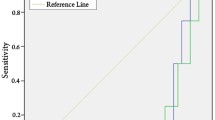Abstract
Among solid organ blunt traumas, the liver and spleen are mostly subject to injury. In addition, the liver is also commonly injured in penetrating traumas because of its size, location, and the ease of injury to the “Glisson Capsule”. Several enzymes are known to be elevated following trauma. In our study, we evaluated the correlation between the levels of serum aspartate aminotransferase, alanine aminotransferase, lactate dehydrogenase, and gamma-glutamyl transpeptidase in 57 patients with blunt trauma to the liver and compared these values to the American Association for the Surgery of Trauma trauma grading system. Additionally, we compared the enzyme level elevations in these patients to the enzyme levels of 29 healthy subjects. As expected, we found significant elevations in enzyme levels of trauma patients compared to the control group. The calculated point estimates were not significantly different between grades 1 and 2 trauma. However, grade 3 trauma group showed a significant increase in enzyme levels.







Similar content being viewed by others
References
Moore EE, Shackford SR, Pachter HL, McAninch JW, Browner BD, Champion HR et al (1989) Organ injury scaling: spleen, liver, and kidney. J Trauma 29:1664–6
Moore EE, Cogbill TH, Jurkovich GJ, Shackford SR, Malangoni MA, Champion HR (1995) Organ injury scaling: spleen and liver. J Trauma 1994(38):323–4
Ritchie AH, Williscroft DM (2006) Elevated liver enzymes as a predictor of liver injury in stable blunt abdominal trauma patients: case report and systematic review of the literature. Can J Rural Med 11(4):283–287
Cogbill T, Moore E, Feliciano D et al (1992) Hepatic enzyme response and hyperpyrexia after severe liver injury. Am Surg 58:395–9
Strawn T, Williams H, Flint L (1980) Prognostic significance of serum biochemical changes following liver trauma. Am Surg 46:111–5
Risholm L, Sullivan L (1966) Changes in the transaminase and phosphatase activity of the blood and the occurrence of haemobilia following experimental liver trauma in the rabbit. Acta Chir Scand 131:495–8
Sahdev P, Garramone RR Jr, Scwartz RJ, Steelman SR, Jacobs LM (1991) Evaluation of liver function tests in screening for intra-abdominal injuries. Ann Emerg Med 20(8):838–41
Aragon G, Younossi ZAM (2010) When and how to evaluate mildly elevated liver enzymes in apparently healthy patients. Cleve Clin J Med 77(3):195–204
Haftel A, Lev R, Manhour G et al (1988) Abdominal CT scanning in pediatric blunt trauma. Ann Emerg Med 17:684–689
Oldham KT, Guice KS, Kaufman RA (1984) Blunt hepatic injury and elevated hepatic enzymes: a clinical correlation in children. J Pediatr Surg 19:457–461
Conflict of interest
The authors declare that they have no conflict of interest.
Author information
Authors and Affiliations
Corresponding author
Rights and permissions
About this article
Cite this article
Arslan, G., Gemici, A.A., Yirgin, I.K. et al. Liver trauma grading and biochemistry tests. Emerg Radiol 20, 379–384 (2013). https://doi.org/10.1007/s10140-013-1140-x
Received:
Accepted:
Published:
Issue Date:
DOI: https://doi.org/10.1007/s10140-013-1140-x




